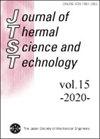Coupled heat transfer characteristics on gas-solid reacting interface in carbon-oxygen dissociating environment for spacecraft entry flow
IF 0.9
4区 工程技术
Q3 THERMODYNAMICS
引用次数: 5
Abstract
Planetary spacecrafts, such as return capsules and Mars entry vehicles, enter the atmosphere at extremely high speeds, and therefore high-enthalpy dissociated aerodynamic environment occurs around the heat shield (Gnoffo, 1999). Such severe environment brings complex interface heat transfer processes between the gas and solid domains. Moreover, deep space exploration, such as hypersonic Mars entry mission, causes an additional carbon-oxygen (C-O) reacting environment, which further brings some new challenges to the evaluation of interface heat transfer characteristics (Reynier, 2014). Accurate and reliable prediction of interface heat transfer is the premise and basis for effectively ensuring the safety of the spacecraft thermal protection system (TPS), reducing design redundancy and increasing the effective payload (Duffa, 2013). With the continuous and in-depth development of high-performance computing, using the numerical technology to characterize fluid mechanics, structural heat transfer, interface chemistry and their interaction has become an effective way to solve this problem (Milos and Rasky, 1994). Early researches on interface heat transfer characteristics were done by solving the compressible gas dynamics equations with simple mathematical closure on the solid surface (Wright, et al., 2010). No interface chemistry was the * State Key Laboratory of Aerodynamics, China Aerodynamics Research and Development Center 6 Second Ringroad South Section, Mianyang, Sichuan, 621000, P. R. China E-mail: xiaofeng.yang@cardc.cn ** College of Aeronautics and Astronautics, National University of Defense Technology 109 Deya Road, Changsha, Hunan, 410073, P. R. China航天器入口流碳氧解离环境下气固反应界面耦合换热特性
行星航天器,如返回舱和火星进入飞行器,以极高的速度进入大气层,因此在隔热罩周围会发生高焓解离空气动力环境(Gnoffo, 1999)。这种恶劣的环境带来了复杂的气固界面换热过程。此外,深空探测,如高超声速火星进入任务,造成了额外的碳氧(C-O)反应环境,这进一步给界面传热特性的评估带来了一些新的挑战(Reynier, 2014)。准确可靠的界面传热预测是有效保证航天器热防护系统(TPS)安全、减少设计冗余、增加有效载荷的前提和基础(Duffa, 2013)。随着高性能计算的不断深入发展,利用数值技术表征流体力学、结构传热、界面化学及其相互作用已成为解决这一问题的有效途径(Milos and Rasky, 1994)。早期对界面传热特性的研究是通过在固体表面上求解具有简单数学闭包的可压缩气体动力学方程来完成的(Wright, et al., 2010)。无界面化学是*空气动力学国家重点实验室,中国空气动力研究与发展中心,四川绵阳二环路南段6号,621000,中国。E-mail: xiaofeng.yang@cardc.cn **国防科技大学航空航天学院,湖南省长沙市德雅路109号,410073
本文章由计算机程序翻译,如有差异,请以英文原文为准。
求助全文
约1分钟内获得全文
求助全文
来源期刊
CiteScore
2.30
自引率
8.30%
发文量
0
审稿时长
5 months
期刊介绍:
JTST covers a variety of fields in thermal engineering including heat and mass transfer, thermodynamics, combustion, bio-heat transfer, micro- and macro-scale transport phenomena and practical thermal problems in industrial applications.

 求助内容:
求助内容: 应助结果提醒方式:
应助结果提醒方式:


